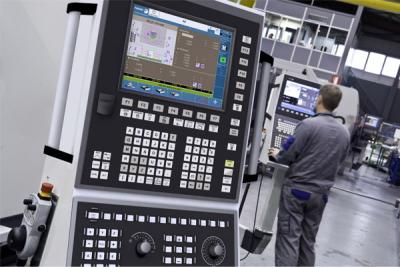
The CNC 8060 T from Fagor Automation USA is a product adapted to the requirements of production lathes, high-speed machining centers or machines demanding high accuracy and high-end features.
Advances to make your job easier:
- Touch screen
- High definition graphics
- More than 500 Mb of memory as standard in all CNC models, expandable via Compact Flash.
- Free simulator on PC
- Pop-up-based browsing (Fagor exclusive)
High-speed machining:
- HSSA (High Speed Surface Accuracy) machining system (Fagor exclusive)
- Nanometric accuracy, splines, etc.
- Automatic tool management in long machining operations
Choose from four programming methods:
- Standard ISO language
- Parametric language
- ProGTL3 language
- IIP interactive language (Interactive Icon-based Pages)
- Also supporting CAD/CAM programs and programs generated by other CNCs
A variety of canned cycles for milling and turning:
- Many turning cycles.
- Many facing cycles.
- Wide selection of drilling and threading cycles.
- Constant-pitch and variable-pitch threading.
- Wide selection of threading cycles.
- Many grooving cycles.
- Profile cycle along the X axis.
- Profile cycle along the Z axis.
- Pocket cycles in the XC, ZC planes.
- Pocket cycles in the XY, YZ planes.
- Multiple pocket cycles.
- 2D pockets for user-defined shapes.
Contact Details
Related Glossary Terms
- centers
centers
Cone-shaped pins that support a workpiece by one or two ends during machining. The centers fit into holes drilled in the workpiece ends. Centers that turn with the workpiece are called “live” centers; those that do not are called “dead” centers.
- computer numerical control ( CNC)
computer numerical control ( CNC)
Microprocessor-based controller dedicated to a machine tool that permits the creation or modification of parts. Programmed numerical control activates the machine’s servos and spindle drives and controls the various machining operations. See DNC, direct numerical control; NC, numerical control.
- flash
flash
Thin web or film of metal on a casting that occurs at die partings and around air vents and movable cores. This excess metal is due to necessary working and operating clearances in a die. Flash also is the excess material squeezed out of the cavity as a compression mold closes or as pressure is applied to the cavity.
- gang cutting ( milling)
gang cutting ( milling)
Machining with several cutters mounted on a single arbor, generally for simultaneous cutting.
- grooving
grooving
Machining grooves and shallow channels. Example: grooving ball-bearing raceways. Typically performed by tools that are capable of light cuts at high feed rates. Imparts high-quality finish.
- milling
milling
Machining operation in which metal or other material is removed by applying power to a rotating cutter. In vertical milling, the cutting tool is mounted vertically on the spindle. In horizontal milling, the cutting tool is mounted horizontally, either directly on the spindle or on an arbor. Horizontal milling is further broken down into conventional milling, where the cutter rotates opposite the direction of feed, or “up” into the workpiece; and climb milling, where the cutter rotates in the direction of feed, or “down” into the workpiece. Milling operations include plane or surface milling, endmilling, facemilling, angle milling, form milling and profiling.
- threading
threading
Process of both external (e.g., thread milling) and internal (e.g., tapping, thread milling) cutting, turning and rolling of threads into particular material. Standardized specifications are available to determine the desired results of the threading process. Numerous thread-series designations are written for specific applications. Threading often is performed on a lathe. Specifications such as thread height are critical in determining the strength of the threads. The material used is taken into consideration in determining the expected results of any particular application for that threaded piece. In external threading, a calculated depth is required as well as a particular angle to the cut. To perform internal threading, the exact diameter to bore the hole is critical before threading. The threads are distinguished from one another by the amount of tolerance and/or allowance that is specified. See turning.
- turning
turning
Workpiece is held in a chuck, mounted on a face plate or secured between centers and rotated while a cutting tool, normally a single-point tool, is fed into it along its periphery or across its end or face. Takes the form of straight turning (cutting along the periphery of the workpiece); taper turning (creating a taper); step turning (turning different-size diameters on the same work); chamfering (beveling an edge or shoulder); facing (cutting on an end); turning threads (usually external but can be internal); roughing (high-volume metal removal); and finishing (final light cuts). Performed on lathes, turning centers, chucking machines, automatic screw machines and similar machines.
